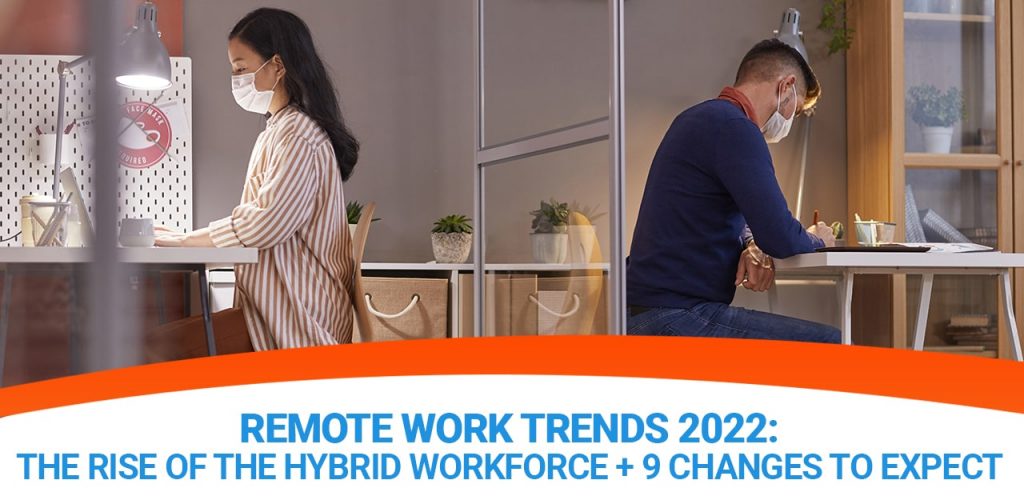Remote Work Trends 2022: The Rise of the Hybrid Workforce + 9 Changes to Expect

The future of work is looking bright — and hybrid!
Thanks to technological advancements and (ironically) a deadly pandemic that forced many of us to work from home, the way we work is changing rapidly. And with more and more people working remotely, the traditional office setup is becoming a thing of the past.
What does this mean for the future of work? What workplace trends can we expect in the next few years? And how do we adapt so that we don’t get left behind? Let’s take a closer look at the rise of the hybrid workforce and nine changes to expect in 2022.
Remote working goes mainstream
While the last half-century saw a surge in full-time employment and white-collar office jobs, the last decade saw the rise of the gig economy, workers prioritizing flexibility over upward mobility, and the proliferation of apps and services that have made remote work accessible to individuals around the world.
Prior to this, many companies, especially those in tech, had already seen that employees can be just as productive working off-site as they could while seated in a cubicle. Surveys also showed that flexible work setups led to happier and more productive employees. Workers have also cited better mental health and better work life balance as key reasons for choosing remote work arrangements.
As work from home (WFH) and work from anywhere (WFA) arrangements became popular among knowledge workers, more and more companies began to allow for flexible work conditions to accommodate family needs and personal preferences.
And then the COVID-19 pandemic happened.
COVID forces millions to work remotely
As COVID-19 spread around the world, the subsequent lockdowns gave companies no choice but to rely on telecommuting. And now, as the world transitions to a pandemic-altered normal, many employees who have experienced what it’s like to work remotely don’t want to return to the office, at least not on a full-time basis.
According to Owl Labs, 1 in 2 people surveyed said that they wouldn’t return to their job if remote work wasn’t on the table. 23% of full-time employees would take a pay cut of over 10% in order to work from home at least some of the time and 77% agree that after COVID-19, being able to work from home would make them happier in their job.
What this tells us is that working remotely is no longer a perk or a nice-to-have, it’s now a must-have for many employees. And as the number of remote workers continues to grow, so too will the demand for remote-friendly policies and tools from employers.

Fortunately, many businesses are keeping their employees remote — not just out of necessity, but out of choice. Some have implemented a hybrid arrangement, with some employees working on-site and some working remotely. In some companies, employees are allowed to work from headquarters a few days a week and from wherever they want the rest of the time. Around the world, companies have ditched the cubicles and transformed offices into meeting hubs, where employees can meet face-to-face with their colleagues only when they need to.
This newfound acceptance of remote working and hybrid setups is indicative of a larger trend: businesses are acknowledging that, in the modern workplace, employees can be just as productive working remotely as they are in the office.
7 remote work trends to expect in 2022 and beyond
As The Great Resignation has shown, the traditional office setup is no longer appealing to many employees. It’s clear that remote work is here to stay, but what else can we expect? Here are seven remote work trends we’re likely to observe in 2022 and the coming years:
1. The rise of the hybrid workforce
More and more companies are realizing the benefits of a hybrid workforce — a mix of remote and in-office employees. With the right tools and policies in place, a hybrid workforce can be just as productive as an all-remote or all-in-office setup. Hybrid workplaces are also more flexible, which can be a key advantage in the ever-changing world of work.
2. The proliferation of digital nomads
As travel restrictions ease and more companies adopt remote-friendly policies, the number of digital nomads is likely to skyrocket. Digital nomads are individuals who work from anywhere in the world, as long as they have a reliable internet connection. They often travel to different countries and work from coffee shops, co-working spaces, or their own homes. In the past, digital nomads consisted largely of individuals in the tech and creative industries. But in the coming years, we’re likely to see a wider range of professionals — from almost every industry — taking advantage of the freedom and flexibility that remote work offers.
3. The traditional workforce will become more diverse
The sharp increase in remote work opportunities is great news for anyone looking for a more flexible work arrangement, and it’s also slowly chipping away at the traditional idea that every employee must be in an office setting from 9 to 5. This shift has made the workforce more friendly to traditionally underrepresented groups such as working moms and those with disabilities. In the coming years, we can expect to see even more diversity in the traditional workforce as remote work becomes more accepted and widespread.
4. The world is becoming less of a “9-to-5” society
In the past, the traditional workplace was pretty standard: Employees would work from 9 to 5 in an office setting, and that was about it. But with advances in communication technologies, that’s no longer the case. The workforce is becoming more dispersed, more diverse, and more flexible, and as a result, the lines between our personal and professional lives are blurring more than ever before.
5. The gig economy will continue to grow
With more and more people choosing to freelance or work on a contract basis, the gig economy is only going to continue to grow. This trend is especially prevalent among millennials, who are often looking for more flexibility and variety in their work lives. The gig economy is also a great option for those who want to work from home or travel the world while earning an income.
6. Job roles will become more specialized
As the world of work becomes more complex and specialized, job roles are becoming more specialized as well. In the coming years, we can expect to see an increase in roles that require specific skills and knowledge, such as data analysis, SEO marketing, and social media management. This trend will make it even more important for employees to keep up with the latest trends and technologies in their respective fields.
7. Training and development programs will be more important than ever
In an age where job roles are becoming more specialized and the workforce is becoming more diverse, training and development programs will be more important than ever. Employees will need to be constantly learning new skills and keeping up with the latest trends in their fields if they want to stay ahead of the competition.
8. Employers will place greater emphasis on employee wellbeing
The COVID-19 pandemic and subsequent Great Resignation has made one thing abundantly clear: employee wellbeing is quickly becoming one of the most important factors when it comes to job satisfaction and employee retention. This is likely to be a long-term trend, as employers realize that a happy and healthy workforce is a productive workforce. In the coming years, we can expect to see more employers offering wellness programs, flexible work arrangements, and mental health support.
9. HR and talent management practices will evolve
As the workforce becomes more dispersed and diverse, HR and talent management practices will need to evolve in order to keep up. Employers will need to find new ways to assess candidates’ qualifications, identify top talent, and keep track of employee performance. In addition, employers will need to develop new strategies for onboarding and retention in order to keep their best employees from leaving.

How to stay ahead of remote work trends
As we enter into a new era of work, there are many uncertainties about what the future holds. But that doesn’t mean that the future is bleak; on the contrary, the future of work is exciting and full of possibilities. Employees will have more flexibility and control over their work lives than ever before, and employers will have access to a more diverse and skilled workforce.
If you’re looking to stay ahead of remote work trends, here are a few tips:
1. Embrace remote work
The first step is to embrace remote work and see it as an opportunity, not a challenge. Embracing remote work means changing the way you think about work and employees. It means realizing that employees are no longer tethered to their desks in the office and that they can be just as productive (if not more productive) working from home. It also means realizing that employees don’t need to be in the office to be part of the team and that they can contribute just as much (if not more) to the company’s success by working remotely.
2. Adopt a remote-friendly policy
The second step is to adopt a remote-friendly policy. This means setting up a remote work policy and training employees on how to be productive while working remotely. It also means creating a communication plan so that employees can stay connected with their team and investing in collaboration tools so that they can easily share files and ideas.
3. Train managers on how to manage remote teams
Prepare managers to work with remote teams. This means teaching them how to give employees the freedom and flexibility they need to be productive, how to stay connected with their team, and how to handle any challenges that may come up.
4. Invest in technology
Invest in the technology needed to support remote work. This means investing in video conferencing tools, project management tools, and messaging apps so that employees can easily connect with each other.
5. Build a remote-friendly company culture
Company culture is key to success in a remote work environment. This means creating a company culture that supports work-life balance, collaboration, and innovation. It also means encouraging employees to take time off when they need it and promoting work-from-home policies.
6. Encourage transparency and communication
Transparency and communication are essential in a remote work environment. This means making sure that employees have access to the same information, that they are able to communicate with each other easily, and that they feel comfortable asking questions.
7. Train employees on how to be productive while working remotely
Employees who are used to working in an office may need to be trained on how to be productive while working remotely. This means teaching them how to set boundaries, how to stay connected with their team, and how to manage their time.
8. Communicate, communicate, communicate
With so many different people working from so many different places, effective communication is more essential than ever. Make sure that you are communicating with employees regularly, both verbally and in writing, and that you are encouraging them to do the same.
The future of work is changing, and the rise of the hybrid workforce is just the beginning. Embrace remote work and prepare your business for the changes to come. For more information on preparing for the future of work, get in touch with our Business Growth Specialists.
Business leaders weigh in
We asked these CEOs and company founders whether or not hybrid work arrangements are here to stay and how they overcame hybrid workforce challenges in their organizations. Here’s what they had to say:
“We are going into hybrid work with the mindset of complete flexibility. We’re planning to optimize our onboarding process so we have both online and in-office training materials. We are also planning to keep our usual project management softwares in place… I would advise every business to not feel an immediate pressure to do another 180 with your operations. As long as you maintain thorough and constant communication, the hybrid environment should come smoothly to your business.”
-William Schumacher, CEO and founder, Uprising Food
“Most companies especially in the tech sector will stick with a hybrid model where employees will get to decide a certain number of hours that they would want to work from home and I think that’s a perfectly reasonable
idea because if they can get the job done at the same pace as their office counterparts, then what’s the need for calling them in? Businesses can save on utility bills this way and improve their Profit and Loss statement at the end of the day.”-Austin Fain, CEO, Perfect Steel Solutions
“I think that what is going to stick will be the option for employees to choose what work environment works best from them. Knowing that employees might leave their company for a new one that allows them to work how they want will force employers to realize that they need to cater to their employees’ desires.:
-Brian Donovan, CEO, Timeshatter
“Hybrid work environments can be challenging for people not used to managing their own time. I always suggest implementing time blocking to make it easier to plan work in the right place at the right time. After the pandemic ends, I believe more employers will be offering remote or hybrid work. We are experiencing a talent shortage and flexibility is one of the most in-demand perks companies can offer to compete.”
-Nikki Gonzales, Head of Growth and Partnerships, Quotebeam
“The greatest challenge we have faced as a hybrid team is the issue of culture erosion. Remote employees report feeling isolated despite being 100% committed and loyal to the organization. The lack of in-person interactions can take a toll on the organization’s culture. We’ve tried to work around this by introducing meaningful activities such as virtual coffee dates, casual chat rooms, game nights, and quarterly meetups where all employees can get together in person to discuss complex aspects of a project and catch up over a company-sponsored lunch, dinner, or happy hour.”
-Ben Lamarche, General Manager, Lock Search Group
[activecampaign form=68]











